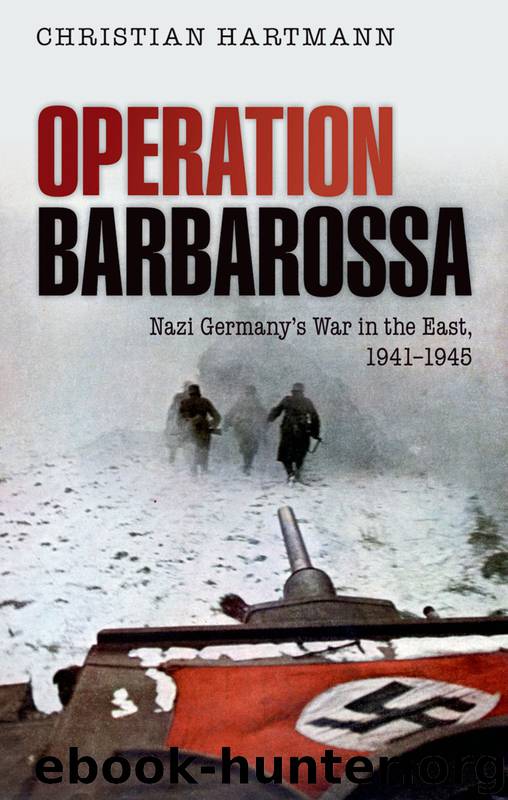Operation Barbarossa: Nazi Germany's War in the East, 1941-1945 by Hartmann Christian

Author:Hartmann, Christian
Language: eng
Format: epub
Publisher: OUP Oxford
Published: 1945-12-14T16:00:00+00:00
ILLUSTRATION 6. Soviet prisoners of war take a journey into captivity from which many of them would never return
At first, ‘only’ two groups of prisoners were explicitly condemned to death by the German leadership: the political officers, the so-called commissars, and then, after autumn 1941, Soviet prisoners of Jewish origin. Around 50,000 of the latter lost their lives to the German ‘screening’, which was carried out by the Task Forces, by the police, or sometimes also by the Wehrmacht itself. Sometimes Soviet officers were shot at the same time, as well as ‘Asiatics’, women, and also, later, invalid prisoners, though these were not part of a systematic programme of murder.
The opposite was true for the commissars. Almost 5,000 were killed by the troops at the front, another 5,000 in the prisoner-of-war camps or the other rear areas. In places, the order to murder was construed by the army in even more wide-ranging terms than it was meant; in others, such an order led to discontent and criticism. From summer 1941 onwards, ‘commanders, officers, and troops’ repeatedly requested that the order be rescinded. Such a request was not normal. In the short history of the Third Reich, there are relatively few recorded instances in which criticism from below caused the political decision-makers to relent. This time, it was successful. On 6 May 1942, Hitler suspended the order regarding commissars—‘on a trial basis’, though it was never put back into effect.
These two groups of victims, however, represent only a small proportion of the total number of Soviet prisoners of war. Of the rest, most survived at first, at least until autumn 1941. Although there were killings while the prisoners were taken and also often during the torturously long marches to the prison camps, and although conditions upon arrival could be very tough, the differences between camps were still very large at that point. ‘Everything is so peaceful, so well ordered,’ a German sergeant was able to write about his transit camp in August 1941. But the tone of his letters home soon changed completely. ‘This listless dying all around one is terrible,’ he wrote in a letter from November. ‘When they come to eat, stiff with frost—today it’s minus ten, yesterday it was minus fifteen degrees during the day—they stagger, fall over, die at our feet.’
This constant, slow, and quiet dying soon became the norm in all ‘Russian camps’. In autumn 1941, a series of problems all came to a head at the same time: the German offensive on Moscow had become bogged down, which went hand-in-hand with an acute crisis in the supply of the Eastern Army; the cold and wet time of year had begun; and the Wehrmacht’s victories in the ‘cauldron’ battles of Kiev, Vyazma, and Bryansk had brought another 1.5 million prisoners into the camp system. Since only half a million had been transported west to the Reich by the end of 1941, they bunched up in the zone of military operations. Of course, these were partly factors
Download
This site does not store any files on its server. We only index and link to content provided by other sites. Please contact the content providers to delete copyright contents if any and email us, we'll remove relevant links or contents immediately.
| Belgium | France |
| Germany | Great Britain |
| Greenland | Italy |
| Netherlands | Romania |
| Scandinavia |
Room 212 by Kate Stewart(5040)
The Crown by Robert Lacey(4724)
Endurance: Shackleton's Incredible Voyage by Alfred Lansing(4677)
The Iron Duke by The Iron Duke(4293)
The Rape of Nanking by Iris Chang(4139)
Joan of Arc by Mary Gordon(4016)
Killing England by Bill O'Reilly(3953)
Say Nothing by Patrick Radden Keefe(3903)
I'll Give You the Sun by Jandy Nelson(3359)
Shadow of Night by Deborah Harkness(3305)
Hitler's Monsters by Eric Kurlander(3269)
Mary, Queen of Scots, and the Murder of Lord Darnley by Alison Weir(3152)
Blood and Sand by Alex Von Tunzelmann(3140)
Darkest Hour by Anthony McCarten(3072)
Eleanor & Park by Rainbow Rowell(3063)
Margaret Thatcher: The Autobiography by Thatcher Margaret(3029)
Red Famine: Stalin's War on Ukraine by Anne Applebaum(2873)
Book of Life by Deborah Harkness(2868)
The One Memory of Flora Banks by Emily Barr(2803)
